Uvle: Difference between revisions
No edit summary |
|||
| Line 102: | Line 102: | ||
*[http://iskwiki.upd.edu.ph/images/a/a5/How_to_limit_viewers_of_my_files_to_particular_students_only.pdf How to limit viewers of my files to particular students only] | *[http://iskwiki.upd.edu.ph/images/a/a5/How_to_limit_viewers_of_my_files_to_particular_students_only.pdf How to limit viewers of my files to particular students only] | ||
*[http://iskwiki.upd.edu.ph/images/0/01/How_to_enable_Plagiarism_detection_of_UVLe.pdf How to enable Plagiarism detection in UVLe/OVLe] | *[http://iskwiki.upd.edu.ph/images/0/01/How_to_enable_Plagiarism_detection_of_UVLe.pdf How to enable Plagiarism detection in UVLe/OVLe] | ||
* [[How to reuse a course on UVLe]] | |||
<br /><br /> | <br /><br /> | ||
'''Students''' | '''Students''' | ||
---- | ---- | ||
Revision as of 00:01, 3 February 2013
The University Virtual Learning Environment (UVLê - uvle.up.edu.ph) is the online course management system of the University of the Philippines that enables instructors to
- organize their classes around topics, themes, weekly schedules
- upload digitized materials and share them with students
- link relevant materials from other sites
- post announcements that will be sent out automatically to students
- create online forums and wikis for students to participate in.
- "UVLe" - Episode 1 - review it!
Powered by an open-source application called Moodle, UvLe is maintained and operated by the Diliman Interactive Learning Center (DILC). The name "UVLe" is a homophonic play of "Oblê" that's a contraction of "Oblation"--a university symbol. UVLê is a platform for students to freely interact or collaborate with their instructors and fellow students. It is constructed with a pedagogy that imbibes self-discovery, self-instruction, "learning by doing" and experimentation. Learn more about Moodle's pedagogy.
UVLe is now version 2.2, based on Moodle 2.2.3.

Modules, Plugins, and Blocks
In addition to standard Moodle 2.x features, UVLe 2.x now has the following modules, plugins, blocks:
- The Dock - provides shortcuts to the main UVLe page, to the courses the user is currently enrolled in, to the user's files, to blogs, to messages, to the form for requesting courses (visible only to users with current teacher role), to the user's contacts.

Resource Uploading and Sharing
- GoogleDocs Reposity - enables one to directly share one's GoogleDocs files via UVLe. This feature will be visible after one clicks on "Turn editing on" | "Add a resource" | "File" or "Folder".
- File PIcker - enables the uploading and sharing of files, including those on GoogleDocs
Evaluation Tools
- Crot Tool for Plagiarism Detection - helps teachers detect plagiarized materials that students submit on UVLe. In your course page, use this feature under "Add an activity" | "Advanced Uploading of Files"
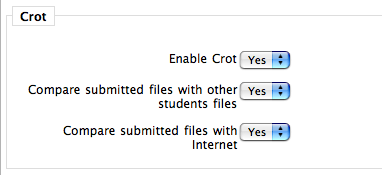
- See Also: "How to prevent plagiarism" for further details on the detection tool and "Busting Plagiarism" for the substantive issues in plagiarism.
- See Also: "How to prevent plagiarism" for further details on the detection tool and "Busting Plagiarism" for the substantive issues in plagiarism.
Communication
- Quickmail - enables a teacher to quickly email some or all students in the course through a checkbox list. To be able to use Quickmail, the teacher or course manager needs to add the Quickmail block to the course page.
Mind Mapping Tools
- FreeMind[1] - output .mm file (ex: this) of FreeMind can be displayed on UVLe. Download FreeMind Mac, Windows, Linux.
See Gallery of Examples.
To create and save simple "mind maps" on UVLe/OVLe itself, use Mindmap (see below).
- Mindmap[2] - enables the teacher or course manager to provide a "mind mapping" activity area in a course where simple mind maps can be created and saved. This feature is made available via Add an activity under a course topic (after you click on Turn editing on).

These tools require Java-enabled browsers.
Science and Math Tools
- Tex Notation Filter - enables the addition of mathematical expressions in UVLe pages. See also Tutorials.
- Molecule Visualization Engine (Jmol) enables users to display animated 3D models of molecules. This requires java plugin (preferably the latest version) on your browser. See also "Displaying molecules using Jmol and PDB files."
Organizational Tools
- Committee Manager - an administration module that enables one to manage committees, upload public and private files, create events (meetings), plan meetings, manage agenda, minutes, business arising from previous meetings. Access is via "Add an activity" in your UVLe page.
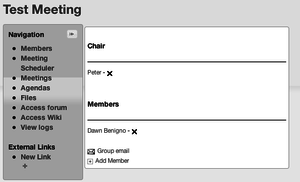
- UVLe User Admin Module - a module to manage users who cannot be authenticated by UP Diliman LDAP Server or those who cannot have UP Webmail Accounts
- Reservation - enables an UVLe user (with at least a teacher role) to use UVLe as a reservation system for a lab or any facility, for exams or consultation schedules. To activate in a page, turn editing on and 'Add an activity' | 'Reservation.' The number of slots, the opening and closing dates can be specified. Students can cancel their reservation. Reservation can also be limited by Department, Major, Course and additional categories can be requested from Team UVLe.
This reservation system is limited by slot numbers rather than by time blocks. A "time slot" based reservation system may become available in future updates.

- Illustrative uses:
- a teacher wants to hold consultation meetings with her 30 students during her consultation period in September. Instead of doing a back-and-forth of emails trying to schedule such meetings, she sets up a 'Reservation' activity for her students so that they themselves can just sign up via UVLe, given the limited slots per period.
- a lab manager deals with the volume of requests for the use of a highly in-demand equipment. Instead of students coming to the lab to sign up, the students can just go to UVLe to file the request at their convenience.
- a college sets up a reservation system on UVLe for the use of its audio-visual room.
- Illustrative uses:
Tutorials
Teachers
- How to set the enrolment key for your course
- Uploading and Sharing of Files
- Adding a block
- Adding Mathematical Expressions
- Displaying Molecules using Jmol and PDB files
- How to create sections (groups) for a single course
- How to reset a course
- How to create Choice Activity
- How to limit viewers of my files to particular students only
- How to enable Plagiarism detection in UVLe/OVLe
- How to reuse a course on UVLe
Students
- How to submit a file as assignment ("Advanced Uploading of Files" Assignment only)
Course Creators
A department or college can designate a staff as course creator. The course creator creates UVLe courses that the department or college faculty can run on UVLe. The department chair or college dean can simply email DILC's Tech Support Team about such assignment.
General Use
- How to change or update email address in UVLe/OVLe
- How to insert or change my profile picture in UVLe/OVLe
- How to manage your private files in UVLe/OVLe
- How to use Helpdesk in UVLe/OVLe
- How to unblock persons in your contact list in UVLe/OVLe
- How to Add contacts in UVLe/OVLe
- How to recover autosaved content in UVLeOVLe
Taking screenshots is important in communicating with DILC's Tech Support Team for them to be able to diagnose problems that UVLe/OVLe users may have.
Cookie problems? Cookies are messages that Web servers pass to your Web browser when you visit Internet sites.
Administrators
More Useful Tools on UVLe
- Quiz statistics report. This is an additional block that can be enabled under a Quiz.
Utilization
As of August 5, 2011, UVLe 2.0 has 19,139 users.
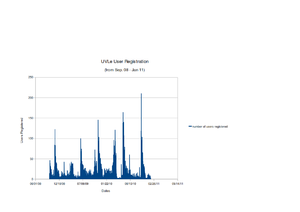

History
Initially developed by 3 UPD students in 2000 with the guidance of the UPCC, UVLê pursues UP's tradition of excellence in academic computing. It won the "Best of Student Projects (Institute of Higher Learning)" in the Asia Pacific Information and Communications Technology Awards in Kuala Lumpur, in 2001.
From the initial hosting of 33 "virtual classes" during the first semester of 2001, the old UVLe had since hosted close to 880 classes for 16,953 users as of September 2008. It got to version 2.3.3, with advanced features indicated on its Change Log.[3] Old UVLe's beta release was on Nov 13, 2000.[4]
While UVLe is now on Moodle code base, it has a long history of technical innovation. (See Old UVle's changelog.) The pre-Moodle UVLe is now known as "old UVLe" and is no longer supported by the UPCC. The current UVLe was launched on October 6, 2008, on the occasion of DILC's 5th anniversary. DILC now operates and supports the new UVLe.
UVLe 2.0 was released on April 11, 2011. Versioning with the revitalized UVLe, however, is different from that of the old one with a different code base. Now it closely follows Moodle versioning.
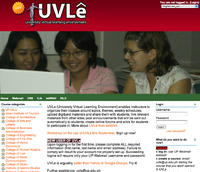
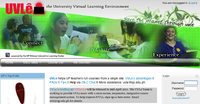
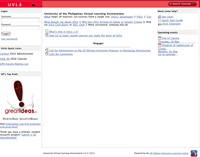
Backup Practice
Snapshots of the UVLe's database and user files are backed up daily in a remote server. UVLe's configs and scripts are also backed up regularly.
To Dos
- integration of more useful Moodle plugins and extensions like
- Mapping Activity or Block
- Easypost
- MOSS
- Administrative Email
- Ajax Marking
- Analytics and Recommendations
- Group selection
- Progress Bar
- Video Consultation Seminars
- Twitter Block
- Birthday
- Skype
- Feedback
- Google Apps
- Certificate
- BigBlueButton
- OU blog
- UVLe User Admin Module
- Moodle-Mediawiki integration
- UVLê-CRS integration. Features: single-click UVLe course creation, integrated submission of grades
- improve ease of use and "sociability" a la Mixable, GradeGuru, Finals Club, OpenStudy
Staff
Peter Sy (Project Management)
Wennie Saludes (Support Manager)
Dawn Benigno (Developer)
Jastinne Cesar Macalalad (Developer)
Past Staff
Mark Benedict Uy (Developer)
Lawrence Libo-on (Developer)
Myra Jill Siason (Technology and Quality Control Consultant)
See Also



